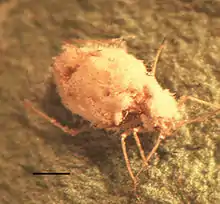Entomophthorales
The Entomophthorales are an order of fungi that were previously classified in the class Zygomycetes. A new subdivision, Entomophthoromycotina, in 2007, was circumscribed for them.[1]
| Entomophthorales | |
|---|---|
.jpg.webp) | |
| Entomophthora muscae | |
| Scientific classification | |
| Domain: | Eukaryota |
| Kingdom: | Fungi |
| Division: | Entomophthoromycota |
| Class: | Entomophthoromycetes |
| Order: | Entomophthorales Winter 1880 |
| Families | |
| Synonyms | |
| |
Most species of the entomophthorales are pathogens of insects. A few attack nematodes, mites, and tardigrades, and some (particularly species of the genus Conidiobolus) are free-living saprotrophs.
The name "entomophthorales" is derived from the Ancient Greek for insect destroyer (entomo- = referring to insects, and phthor = "destruction"). Named after genus Entomophthora in 1856.[2]

Highlighted species
- Basidiobolus ranarum, a commensal fungus of frogs and a mammal pathogen
- Conidiobolus coronatus,[3] a saprotrophic fungus of leaf litter and a mammal pathogen
- Entomophaga maimaiga, a biocontrol agent of spongy moths
- Entomophthora muscae, a pathogen of houseflies
- Massospora spp., pathogens of periodical cicadas
- Pandora, including Pandora neoaphidis, an obligate pathogen of aphids
Biology
Most species of the entomophthorales produce ballistic asexual spores that are forcibly discharged. When not landing on a suitable host, these spores can germinate to make one of several alternate spore forms, including a smaller version of the original spore, or (in some species) an adhesive spore elevated on a very slender conidiophore called a capilliconidiophore.
Classification
Debates have centred on whether the Basidiobolaceae should be included in the entomophthorales, or raised to ordinal status. Molecular systematics approaches so far give an ambiguous answer. Some analyses suggest the Basidiobolaceae are more closely related to certain chytrid fungi than to the entomophthorales.[4] and place it within the Chytridiales order.[5] Others find weak support to maintain them in the Entomophthorales.[6] Morphological characters can be found to support either hypothesis.
- Family Ancylistaceae Schröter 1893
- Ancyclistes Pfitzer 1872
- Capillidium B. Huang & Y. Nie, 2020
- Conidiobolus Brefeld 1884 emend. Humber 1989 [Conidiobolus (Conidiobolus) (Brefeld) Ben-Ze’ev & Kenneth 1982; Conidiobolus (Delacroixia) (Sacc. & Syd.) Tyrrell & MacLeod 1972]
- Macrobiotophthora Reukauf 1912 emend. Tucker 1981
- Family Completoriaceae Humber 1989
- Completoria Lohde 1874
- Family Entomophthoraceae Nowakowski 1877 [Empusaceae Clem. & Shear 1931]
- Subfamily Erynioideae Keller 2005 [Massosporoideae Keller 2005]
- Erynia (Nowakowski ex Batko 1966) Remaud. & Hennebert 1980.emend. Humber 1989 [Zoophthora (Erynia) Nowakowski ex Batko 1966]
- Eryniopsis Humber 1984 (in part)
- Furia (Batko 1966) Humber 2005 [Zoophthora (Furia) Batko 1966; Erynia (Furia) (Batko 1966) Li & Humber 1984]
- Orthomyces Steinkraus, Humber & Oliver 1988
- Pandora Humber 2005 [Erynia (Neopandora) Ben-Ze’ev & Kenneth 1982]
- Strongwellsea Batko & Weiser 1965 emend. Humber 1976
- Tarichium Cohn (1875)
- Zoophthora Batko 1964 emend. Ben-Ze’ev & Kenneth 2005
- Subfamily Entomophthoroideae Keller 2005
- Batkoa Humber 2005
- Entomophaga Batko 1964 emend. Humber 1989
- Entomophthora Fresenius 1856 [Empusa (Triplosporium) Thaxter 1888]
- Eryniopsis Humber 1984 (in part)
- Massospora Peck 1879 emend. Soper 1974
- Subfamily Erynioideae Keller 2005 [Massosporoideae Keller 2005]
- Family Meristacraceae Humber 1989
- Meristacrum Drechsler 1940 emend. Tucker & Humber 1981
References
- Hibbett DS, Binder M, Bischoff JF, et al. (May 2007). "A higher-level phylogenetic classification of the Fungi". Mycol. Res. 111 (Pt 5): 509–47. CiteSeerX 10.1.1.626.9582. doi:10.1016/j.mycres.2007.03.004. PMID 17572334.
- Fresenius, G. 1856. Botanische Zeitung 14, 882-883.
- Dromph KM, Eilenberg J, Esbjerg P (November 2001). "Natural occurrence of entomophthoralean fungi pathogenic to collembolans". J. Invertebr. Pathol. 78 (4): 226–31. doi:10.1006/jipa.2002.5077. PMID 12009804.
- Nagahama, T.; Sato, H.; Shimazu, M.; Sugiyama, J. (1995). "Phylogenetic divergence of the entomophthoralean fungi: evidence from nuclear 18S ribosomal RNA gene sequences". Mycologia. 87 (2): 203–209. doi:10.2307/3760906. JSTOR 3760906.
- Carl A. Batt and Pradip Patel (Editors) Encyclopedia of Food Microbiology (2014), p. 59, at Google Books
- James, T. Y.; Kauff, F.; Schoch, C. L.; et al. (2006). "Reconstructing the early evolution of Fungi using a six-gene phylogeny". Nature. 443 (7113): 818–823. doi:10.1038/nature05110. PMID 17051209.
External links
- G. Benny. Entomophthorales section of Zygomycetes.org
- Entomophthorales at the U.S. National Library of Medicine Medical Subject Headings (MeSH)